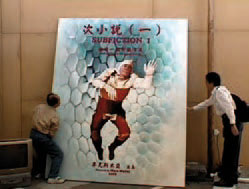subfiction 1
__
2000
Installation
Cities in Amnesia, Festival of Visions – Berlin/Hong Kong
Filmplakat
Modell
Film (2001)
DV auf DVD-PAL
60 min
Regie, Kamera, Montage:
Maix Mayer
Darsteller: The Two Rainbows
2000
Installation
Cities in Amnesia, Festival of Visions – Berlin/Hong Kong
Film poster
Model
Film (2001)
DV on DVD-PAL
60 min
Directed by, Camera, Editing:
Maix Mayer
Actors: The Two Rainbows
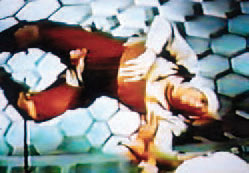
Filmstill (Der schweigende Stern)
Movie still (Der schweigende Stern)
Der schweigende Stern war der erste Science-Fiction-Film der DDR gewesen, der im Jahr 1960 in die Kinos gelangte. Im Gegensatz zur Vorlage des polnischen Autors Stanislaw Lem, dem Roman Die Astronauten (1951), beginnt die Handlung im Jahr 1970. Wissenschaftler finden eine verschlüsselte Botschaft in der Wüste Gobi, die von der Venus stammt. Das Raumschiff „Kosmokrator“ wird zu dem „schweigenden Stern“ geschickt. Zu seiner Crew geh rt neben einem Amerikaner, Russen und Deutschen auch ein chinesischer Linguist und Biologe. Bemerkenswert ist, dass in der Filmhandlung eine Zukunft beschrieben wird, die nur ganze zehn Jahre von der Zeit der Filmproduktion entfernt lag!
Der schweigende Stern (The Silent Star) was the first East German science fiction film to run in cinemas in 1960. In a deviation from the script by Polish author Stanislaw Lem, the story begins in the year 1970. Scientists find a coded message in the Gobi Desert. It comes from Venus. The spaceship “Kosmokrator” is sent to the “silent star.” The crew includes an American, Russians, and Germans as well as a Chinese linguist and biologist. The strange thing is that the movie tells a story in a future only ten years distant from the time of production!
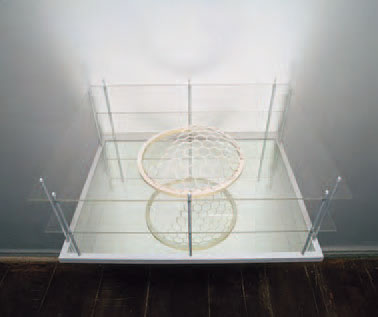
Raumschiffkuppel-Modell
Für die Installation subfiction1 baute die ehemalige Assistentin des DEFA-Filmdesigners Alfred Hirschmeier ein verkleinertes Modell ihrer damaligen Filmarchitektur nach. Diese wabenf rmige Struktur bildet den Hintergrund für den schwerelos im Raumschiff schwebenden chinesischen Darsteller und wurde als Filmstill für das Filmplakat verwendet.
Spaceship dome model
The former assistant of film designer Alfred Hirschmeier constructed a downscaled model of his original movie set for the installation subfiction1. This beehive-like structure forms the backdrop for the Chinese actor drifting in zero gravity and was used as a still for the movie poster.
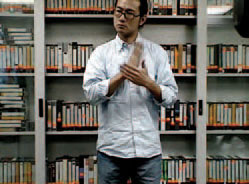
Filmstill
Movie still
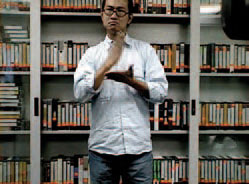
Filmstill
Movie still
Rückübersetzung
Die DDR-Filmproduktion DEFA hatte damals für den Linguisten und Biologen in Der schweigende Stern keinen chinesischen Schauspieler gefunden. Man entschied sich deshalb, die Rolle mit einem damals in Ostberlin lebenden Austauscharbeiter aus China zu besetzen. Dieser Mann verstand kein Deutsch und kannte auch nicht die Filmhandlung. Die bei den Filmaufnahmen gesprochenen chinesischen S tze konnte niemand am Set verstehen. Was sagte der chinesische Arbeiter im Film? Diese Frage bildete den Ausgangspunkt für die Arbeit subfiction1, die eine Dokumentation der Geschichte von bersetzungsschritten ist:
1. Alle Filmsequenzen, in denen der chinesische Linguist in dem Science-Fiction-Film spricht, wurden zusammengeschnitten.
2. In Hongkong engagierte der Künstler einen taubstummen chinesischen Lippenleser, der diese Filmausschnitte simultan in Zeichensprache übersetzte.
3. Sp ter wurde das Video mit dem Lippenleser an gleicher Stelle einer chinesischen Zeichensprachlehrerin vorgeführt, die diese Zeichen simultan in ihre Sprache übertrug.
4. Nach dieser Rückübersetzung erfolgte unter gleichen Bedingungen eine bersetzung ins Englische.
Retro-translation
The East German film production company DEFA could not find a Chinese actor to play the linguist and biologist. It was therefore decided to fill the role with a guest worker from China then living in East Berlin. This man did not understand German and did not know what was going on in the story. No-one on the set could understand the Chinese sentences spoken during filming. What did the Chinese worker in the movie say? This question formed the basis for the work subfiction1, which is a documentation of the history of translations:
1. All the film sequences, in which the Chinese linguist speaks were cut together.
2. The artist went to Hong Kong, where he hired a deaf and dumb Chinese lip-reader to translate these sequences into sign language.
3. Later, video of the lip-reader was shown to a Chinese sign language teacher, also in Hong Kong. She simultaneously translated the signs into Chinese.
4. After this retro-translation, an English translation was made under the same conditions.
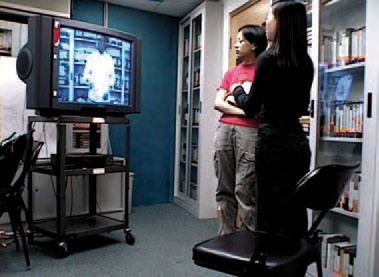
Filmstill
Movie still

Filmstill
Movie still
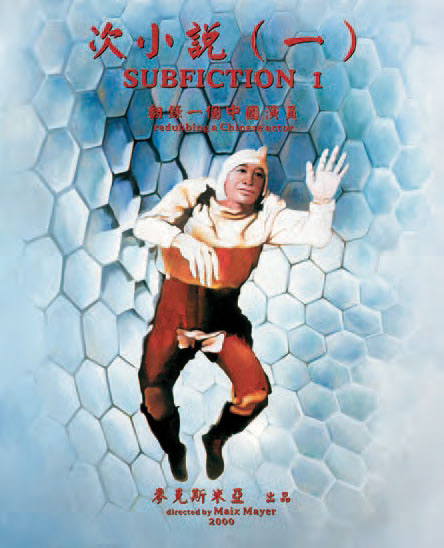
Filmplakat
Zur Dokumentation der bersetzungsprozesse bei subfiction1 wurde der Auftrag für das Filmplakat vergeben, das ehemalige Kinoplakatmaler Hongkongs herstellten. Die Vorlage bildete ein Filmstill des in der Raumschiffkuppel schwebenden chinesischen Darstellers, wobei die Malerei im Gegensatz zur unscharfen Vorlage ein genau ausgeführtes Portr t von diesem zeigte. Die Plakatmaler setzten hierfür an die Leerstelle des kleinen Ausgangsfotos ein für sie typisches chinesisches Gesicht. Wie bei den Lippenbewegungen im Film und den folgenden Rückübersetzungen vollzog sich hier eine Art Rückübersetzung im Visuellen.
Nach der Fertigstellung des Plakats fand ein Interview mit den beiden Malern über ihr pers nliches Verh ltnis zum Kino und dem Medium Film statt. Alle an subfiction1 Beteiligten erhielten für Ihre Aufgaben keinerlei Hintergrundinformationen. W hrend man normalerweise eine m glichst objektive bersetzung anstrebt, sollten bei subfiction1 gerade pers nliche und subjektive Kontexte in den Ergebnissen sichtbar werden.
Film poster
For the documentation of the translation process in subfiction1, the commission for the film poster was given to a firm of old movie poster painters in Hong Kong. Their model was a still from the movie in which the Chinese actor floats through the dome of the space ship. The painting shows a detailed portrait of the actor, in contrast to the out-of-focus still. The poster painters put in a face they considered typically Chinese. Just as with the lip movements in the film and the subsequent retro-translation, a kind of visual retro-translation had taken place here.
After the poster was finished, the two painters were interviewed about their personal relationship with cinema and the medium of film. None of those involved in subfiction1 were given any kind of background information on their tasks. Normally, translators aim for the most objective translation possible. But in “subfiction 1” it was personal and subjective contexts which became visible in the results.
